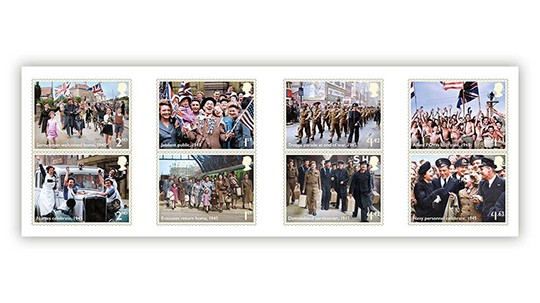End of the Second World War
End of the Second World War
Years of devastating war had finally come to an end. On VE (Victory in Europe) Day in 1945, millions took to the streets to celebrate peace, mourn loved ones and hope for the future.
Here we feature stories from the war, jubilant homecoming scenes as well as remember those who never returned.
WW2 letters
Millions of letters were written during the Second World War. They were a lifeline for the men and women on the frontlines and their family and friends back home. From father to son, soldier to parents and from wife to husband, we feature just a few of the letters written during the war.
Dwight D. Eisenhower's letter to the GPO
In 1944, the Supreme Commander of the Allied Expeditionary Force in Europe sent a letter to Royal Mail thanking staff for their sterling work during World War Two.

VE Day postmark
To commemorate this special occasion, we have produced a special postmark marking the end of the Second World War 75 years ago. The postmark will be printed on stamped post from 7 May.

End of the Second World War Special Stamps
We have released a set of Special Stamps and Collectibles to commemorate 75 years since the end of the Second World War. Our collection features jubilant homecoming scenes after the war’s conclusion and memorials honouring those who never returned.
Eight Special Stamps
These stamps feature photographs capturing the relief at the conflict’s conclusion and the celebrations that service personnel and evacuated children could return home to rebuild their lives.

Memorials
We've produced a special commemorative miniature sheet focusing on memorials honouring servicemen and women who gave their lives to serve their country, as well as victims of the Holocaust.

Yad Vashem, Jerusalem
Israel’s official memorial to the victims of the Second World War Nazi genocide of 6 million Jews (which became known as the Holocaust), Yad Veshem – from the Hebrew for ‘A Memorial and a name’ was established in 1953. The Hall of Names memorial holds the names of millions of Holocaust victims, with some 600 portraits displayed on the exhibit’s cone-shaped ceiling.

Runnymede Memorial
Located near Egham, Surrey, and maintained by the Commonwealth War Graves Commission, the Runneymede Memorial – sometimes known as the Air Forces Memorial – was unveiled by the Queen in 1953. It commemorates over 20,000 airmen and women who were lost during operations from bases in the UK and Europe during the Second World War and who have no known grave.

Plymouth Naval Memorial
Originally unveiled in 1924 to commemorate more than 7,000 sailors who died in the First World War and have no known grave, the memorial was extended in the early 1950s to include nearly 16,000 sailors who perished during the Second World War.

Rangoon Memorial, Myanmar
Situated within the Taukkyan War Cemetery, the Rangoon Memorial commemorates almost 27,000 dead of the British and Commonwealth Land Forces who fell during the Second World War campaigns against the Japanese in Burma (Myanmar) with no known grave.

1995 stamps
This isn't the first time we've commemorated the end of World War Two. These stamps were produced in 1995 to mark the 50th anniversary of VE Day.






